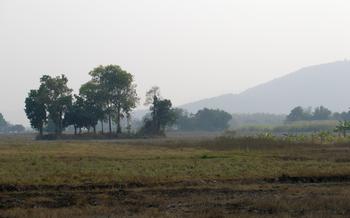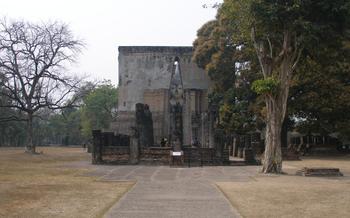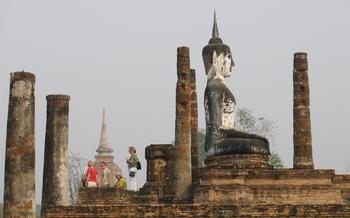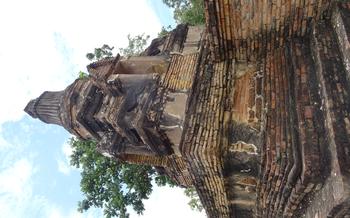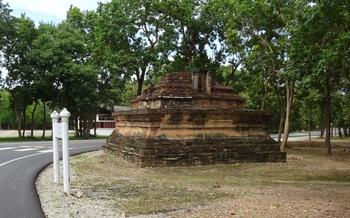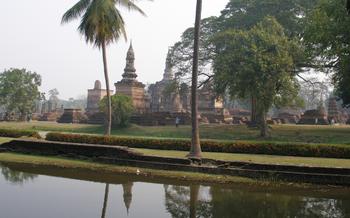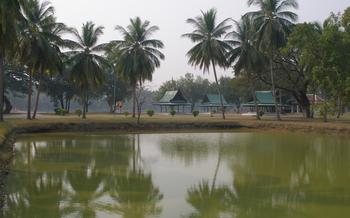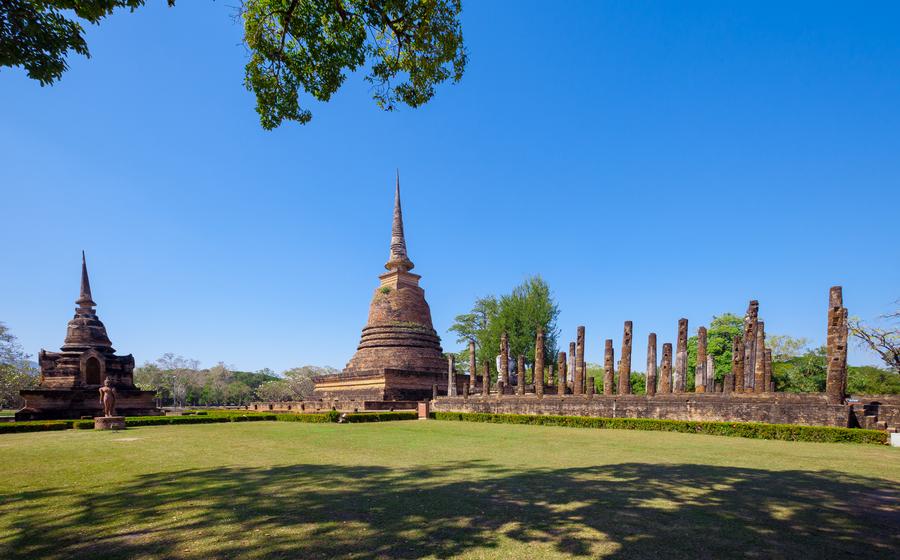
Wat Sra Sri
- Historical Significance
- Wat Sra Sri Temple
- Exploring the Temple Complex
- Local Traditions and Beliefs
- Best Time to Visit Wat Sra Sri:
- Getting There
- Photography Tips
- Respectful Behavior
- Local Cuisine
- Accommodation Options
- Day Trips and Excursions
- Souvenirs and Handicrafts
- Local Festivals
- Language and Communication
- Insider Tip:
Historical Significance
Sukhothai, once the capital of the Sukhothai Kingdom, holds a significant place in Thailand's history. Founded in the 13th century, the kingdom flourished as a center of trade and culture, leaving behind a legacy of stunning temples and architectural marvels. Wat Sra Sri, one of the most prominent temples in Sukhothai, stands as a testament to the kingdom's grandeur and artistic prowess.
The Sukhothai Kingdom emerged as a powerful force in Southeast Asia, establishing its influence over vast territories and playing a pivotal role in shaping the region's cultural and political landscape. Its unique architectural style, characterized by graceful lines, intricate carvings, and towering chedis, set the standard for temple construction throughout the country.
Exploring Wat Sra Sri and other temples in Sukhothai offers a glimpse into this glorious era, allowing visitors to marvel at the ingenuity and craftsmanship of the ancient artisans. The harmonious blend of religious devotion and artistic expression creates a captivating atmosphere that transports visitors back in time, making Sukhothai a must-visit destination for history and culture enthusiasts.
Wat Sra Sri Temple
At the heart of the Sukhothai Historical Park lies Wat Sra Sri, an architectural masterpiece that stands as a testament to the kingdom's artistic prowess. Its most striking feature is the towering chedi, a bell-shaped stupa that dominates the skyline with its graceful curves and intricate ornamentation. The chedi, adorned with delicate stucco work and colorful ceramic tiles, is a symbol of religious devotion and royal authority.
As you explore the temple grounds, you'll encounter other significant structures that contribute to Wat Sra Sri's unique charm. The ordination hall, or bot, is where monks receive their ordination and perform religious ceremonies. Its interior walls are adorned with vibrant murals depicting scenes from the Buddha's life and teachings. The viharn, or assembly hall, is another important structure where monks gather for meditation and chanting. Its roof is supported by massive pillars decorated with intricate carvings, showcasing the exceptional craftsmanship of Sukhothai artisans.
Throughout the temple complex, you'll discover a wealth of intricate carvings and sculptures that adorn every corner. These artworks depict various religious figures, mythological creatures, and scenes from everyday life, offering a glimpse into the beliefs and values of the Sukhothai people. The exquisite craftsmanship and attention to detail in these carvings are a testament to the artistry and devotion of the ancient Sukhothai masters.
Exploring the Temple Complex
Stroll through the temple complex, immersing yourself in its serene atmosphere. Take your time to explore the intricate details of each structure, admiring the craftsmanship and artistry that went into their creation. Visit the nearby Wat Mahathat, another significant temple in Sukhothai, known for its impressive chedi and Buddha image. Climb the temple's staircase to reach the top, where you will be rewarded with panoramic views of the surrounding countryside. From this vantage point, you can appreciate the vastness of the temple complex and the lush greenery that envelops it. The serene atmosphere of the temple grounds invites contemplation and reflection, allowing you to connect with the spiritual essence of this ancient site.
Local Traditions and Beliefs
Wat Sra Sri is not just a historical and architectural marvel but also a place of deep religious significance for the local community. Discover the local beliefs and traditions associated with this sacred site. Observe the rituals and ceremonies that take place at the temple, such as the daily offerings to the Buddha image or the special ceremonies held during festivals. Interact with the local monks and learn about their daily lives, their spiritual practices, and their role in the community. Gain insights into the Buddhist teachings and traditions that have shaped the culture and way of life of the people of Sukhothai. Embrace the opportunity to connect with the local community and experience the vibrant spiritual heritage of this ancient kingdom.
Best Time to Visit Wat Sra Sri:
Plan your visit to Wat Sra Sri during the dry season (November to April) to experience the best weather conditions. The dry season offers clear skies, pleasant temperatures, and minimal humidity, making it ideal for exploring the temple complex and surrounding areas. The temple grounds are well-maintained and easily accessible during this time, allowing you to fully appreciate the architectural beauty and historical significance of Wat Sra Sri.
In contrast, the rainy season (May to October) brings heavy rains and unpredictable weather conditions, which can make exploring the temple grounds challenging. The temple complex may become muddy and slippery, and some areas may be inaccessible due to flooding. Additionally, the overcast skies and high humidity can affect the quality of your photographs and overall experience.
While the dry season is generally the best time to visit Wat Sra Sri, consider the following factors when planning your trip:
-
Crowds: The dry season is also the peak tourist season in Thailand, so you may encounter more crowds at the temple. If you prefer a more tranquil experience, consider visiting during the shoulder months (May and October) when the weather is still favorable but the crowds are smaller.
-
Festivals: If you are interested in experiencing local festivals and cultural events, plan your visit accordingly. The Loi Krathong festival (November) and the Songkran festival (April) are popular festivals that take place in Sukhothai and offer unique opportunities to immerse yourself in Thai traditions.
-
Your preferences: Ultimately, the best time to visit Wat Sra Sri depends on your personal preferences and priorities. Consider your preferred weather conditions, crowd levels, and interests when making your decision.
Getting There
Sukhothai is easily accessible by bus or train from Bangkok. The journey takes around 6-7 hours by bus and 5-6 hours by train. Once in Sukhothai, you can rent a bicycle or motorbike to explore the temple complex and surrounding areas. This is a great way to get around and see the sights at your own pace. You can also hire a local guide for a more immersive and informative experience. Guides can provide insights into the history, culture, and significance of the temples, making your visit even more rewarding.
Photography Tips
When it comes to capturing the beauty of Wat Sra Sri in photographs, there are a few tips to keep in mind. First and foremost, try to visit the temple during sunrise or sunset, as the warm, golden light creates a magical atmosphere that enhances the temple's beauty. A wide-angle lens is your best friend here, allowing you to capture the temple's grandeur and its intricate details in a single shot. Don't be afraid to experiment with different angles and perspectives as well. Climb the temple's staircase for a bird's-eye view or crouch down low to capture the temple's imposing presence from below. Remember, the best photos often come from unexpected angles.
Respectful Behavior
When visiting Wat Sra Sri, it is important to behave respectfully and mindfully. This means dressing modestly and appropriately, covering your shoulders and knees. It is also customary to remove your shoes before entering the temple grounds. Visitors should be mindful of their behavior and avoid disturbing the monks or other visitors. It is considered disrespectful to speak loudly or engage in disruptive activities. Photography is allowed at Wat Sra Sri, but visitors should be respectful and avoid taking photos of monks or other people without their permission. By following these simple guidelines, visitors can ensure that they have a positive and respectful experience at this sacred site.
Local Cuisine
When visiting Sukhothai, don't miss the opportunity to savor the delicious local cuisine. The region is known for its unique blend of flavors and spices, influenced by both Thai and Burmese culinary traditions.
Khao Soi, a northern Thai curry noodle soup, is a must-try dish. This flavorful soup is made with a rich and creamy coconut broth, egg noodles, and a variety of toppings, including chicken, beef, or vegetables. The broth is often infused with spices such as turmeric, cumin, and coriander, giving it a warm and aromatic flavor.
Another popular dish is Sai Oua, a northern Thai sausage. This sausage is made with a mixture of pork, herbs, and spices, and is grilled or fried until crispy. Sai Oua is often served with sticky rice and a dipping sauce.
For a sweet treat, try Khanom Tan, a local dessert made with sticky rice, coconut milk, and sugar. This sweet sticky rice is often served with fresh fruit or ice cream.
To experience the full range of local flavors, visit the nearby night market. Here, you can find a variety of street food stalls selling everything from khao soi and sai oua to fresh fruit and sweets. The night market is a great place to sample different dishes and mingle with the locals.
Accommodation Options
When choosing accommodation in Sukhothai, you will be spoiled for choice with options ranging from budget guesthouses to luxurious resorts. For a truly immersive experience, consider staying in the old city area, where you will be within walking distance of the temples, historical sites, and local markets.
There are several charming guesthouses and boutique hotels in the old city that offer comfortable rooms at affordable prices. These guesthouses often have a traditional Thai design and provide a glimpse into the local way of life. For those seeking a more luxurious stay, there are several upscale resorts located just outside the old city that offer modern amenities and stunning views of the surrounding countryside.
No matter your budget or preferences, you will find a suitable accommodation option in Sukhothai that will make your stay comfortable and enjoyable.
Day Trips and Excursions
Enrich your Sukhothai experience with exciting day trips and excursions to nearby attractions. Just a short distance away, you'll find the Si Satchanalai Historical Park, another UNESCO World Heritage Site. This ancient city boasts a collection of well-preserved temples and ruins, offering a glimpse into the grandeur of the Sukhothai Kingdom. Explore the park's highlights, including the Wat Chang Lom, with its iconic elephant-shaped chedi, and the Wat Mahathat, with its impressive Buddha images.
For a unique and heartwarming experience, consider visiting the Elephant Conservation Center, located approximately 30 kilometers from Sukhothai. This sanctuary provides a safe haven for rescued elephants, offering visitors the opportunity to learn about elephant conservation efforts and interact with these gentle giants. Observe the elephants in their natural habitat, witness their daily routines, and participate in feeding and bathing activities. The Elephant Conservation Center is a must-visit for animal lovers and anyone seeking a meaningful connection with these majestic creatures.
Souvenirs and Handicrafts
When visiting Sukhothai, don't miss the opportunity to take home a piece of the city's rich history and culture by purchasing souvenirs and handicrafts. Local markets and shops offer a wide variety of items to choose from, many of which are made from local materials such as silk, cotton, and ceramics.
Silk is a popular choice for souvenirs, as it is a traditional Thai fabric known for its beauty and durability. You can find silk scarves, clothing, and other items in a variety of colors and patterns.
Cotton is another popular choice for souvenirs, as it is a soft and comfortable fabric that is perfect for the warm Thai climate. You can find cotton clothing, bags, and other items in a variety of colors and styles.
Ceramics are also a popular choice for souvenirs, as they are often intricately decorated with traditional Thai motifs. You can find ceramic bowls, plates, vases, and other items in a variety of sizes and shapes.
In addition to these traditional items, you can also find a variety of other souvenirs in Sukhothai, such as jewelry, paintings, and sculptures. Be sure to bargain for the best price, and remember to purchase your souvenirs from reputable shops to ensure that you are getting genuine products.
Local Festivals
Your trip to Sukhothai can be even more memorable if you plan it to coincide with one of the local festivals. These festivals offer a unique glimpse into Thai culture and provide an opportunity to experience the vibrant atmosphere of the city.
One of the most popular festivals in Sukhothai is the Loi Krathong festival, which takes place in November. During this festival, people gather at rivers and canals to release decorated floats (krathongs) made from banana leaves and adorned with flowers, candles, and incense sticks. The floating krathongs are a symbol of letting go of past grievances and bad luck and sending good wishes for the future.
Another significant festival in Sukhothai is the Songkran festival, which takes place in April. Songkran is the Thai New Year festival and is celebrated with water splashing, parades, and merit-making activities. During this festival, people throw water at each other as a way of cleansing and bringing good luck for the coming year.
If you have the opportunity to visit Sukhothai during one of these festivals, be sure to join in the celebrations and experience the vibrant and festive atmosphere of the city.
Language and Communication
The official language of Thailand is Thai, and it is widely spoken in Sukhothai. However, many people in the tourism industry, such as hotel staff, tour guides, and restaurant workers, can speak English and other languages. It is helpful to learn a few basic Thai phrases, such as "hello" (sa-wat-dee), "thank you" (kop-khun-ka/kha), and "goodbye" (la-korn), to communicate with locals and show respect for their culture. If you need help with communication, you can find English-speaking staff at most hotels and tourist attractions or hire a local guide who can translate for you.
Insider Tip:
For a truly unforgettable experience, visit Wat Sra Sri early in the morning or late in the afternoon. The temple complex is at its most serene during these times, with fewer visitors and a more tranquil atmosphere. As the sun rises or sets, the temple's chedi and other structures cast long shadows, creating a magical and awe-inspiring sight. Take this opportunity to wander through the grounds at your own pace, soak in the beauty of the surroundings, and truly connect with the temple's spiritual essence. Whether you're a history buff, a spiritual seeker, or simply someone who appreciates beautiful architecture, visiting Wat Sra Sri during these quiet hours is an experience you won't soon forget.
